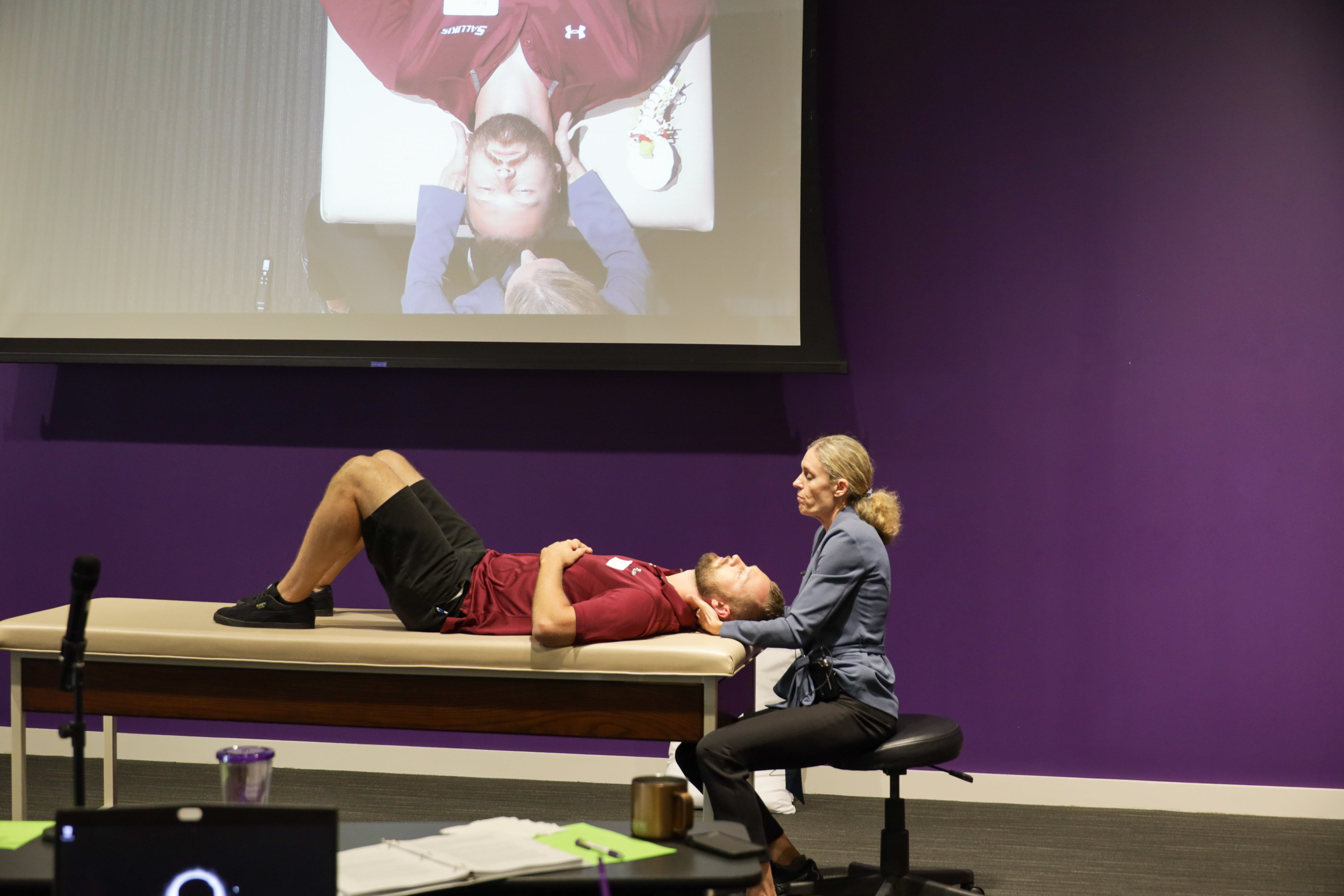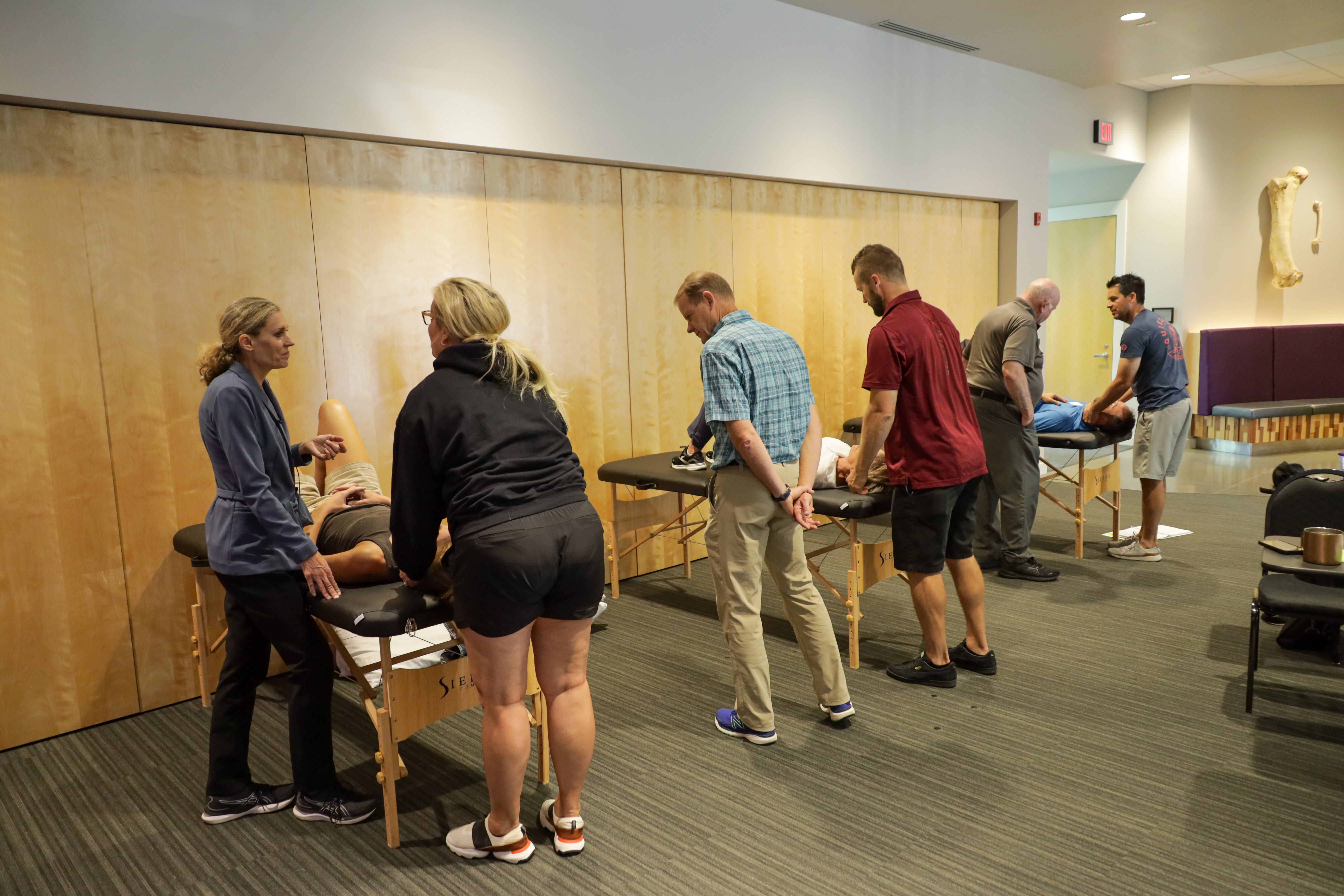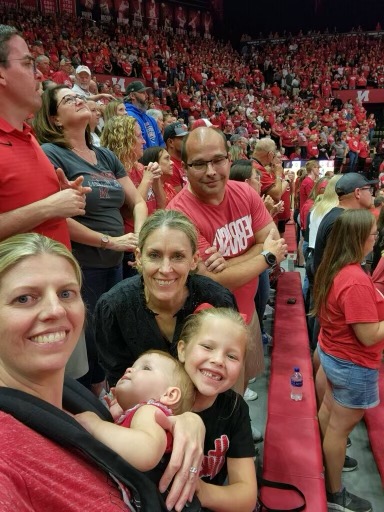I had the great fortune to present Cervical Revolution to an in-person and virtual group, hailing from 10 countries. This course takes the concept of humans’ neurological proclivity for right stance at the pelvis and thorax and carries it up to the neck, teeth, and cranium.
As we know from previous courses, right stance dominance creates complex neuromuscular patterned positions and movements and is heavily influenced by gravity, respiration, and overactive chains of muscles. We introduced a new chain, the temporo-mandibular cervical chain (the TMCC), which, you guessed it, is over-referenced on the right.
The course was greatly enhanced by:
- Our in-person attendees, who were instrumental in demonstration of objective tests and treatment techniques: Lisa Bartels, DPT, PRC; Andrew Consbruck, DPT, PRC; Nate Dickes, PT; Eric Pinkall, PT, PRC; and Kurt Van Kulken, ATC.
- Kelli Reilly, MSPT; Timothy McVaney, DDS; Nancy Wehner, BSDH, COM for sharing clinical observations and expertise.
- Our virtual attendees, for thought-provoking questions and insights, most notably Evan Condry, PT; Alex de la Paz, PT; Christopher Lamb, NASM CPT; Peien Lu, PT; Donne Ordile, PT; Locatelli Rao, DPT, PRC; Laura Regan, DPT; and Alek Skorupa, LMT. To those of you watching in the wee hours of the morning or late at night, thank you for hanging in there and participating in lab.
- Jen Platt, DPT, PRC, for orchestrating everything this weekend – virtual views, answering questions, providing nourishment, and more.
Attendees gained an appreciation for the brain’s need to sense a new floor – at the occiput on atlas (OA) articulation. This articulation, when in its proper position, allows the head to remain in equilibrium with the spine below. Imbalanced left to right sensory processing and motor output occurs when the OA articulation is better sensed and over-referenced on the right side. The very health of the brain may be in peril when we over-reference our right sides too much and for too long. For example, a “twist” results in the neck, compromising a vital opening for brain: the foramen magnum, which houses the brainstem and “cisterns” for cerebral spinal fluid, bathing and protecting our nervous tissue.


The OA compression-decompression (known as OA flexion and OA extension, respectively) reverberates into the cranium at the junction where the occiput meets the sphenoid. This critical junction enables vector forces through the cranium to be distributed to the remaining paired bones of the cranium. When over-referenced on the right, two commonly seen conditions develop at the sphenoid-occipital junction, or synchondrosis: left side-bending and its pathological cousin, right torsion.
These cranial positions, maintained by the Right TMCC, place the paired temporal bones in a patterned position. The temporal bones mirror the ilia of the pelvis and should exhibit alternating internal and external rotation, depending on the leg you’re standing on. The other half of temporal-mandibular joint (TMJ), the mandible, too, is directed and held in patterned state. Without temporal alternating activity, structures within the temporal bones (think mid-brain and vestibular) are deprived of their necessary compression-decompression cycles that are so vital for nerve function. Our mandibles may lose their ability to move side to side, a prerequisite for upright left to right shifting when, say, walking. In addition, alignment of our upper and lower teeth becomes skewed over time and may lead to mal-occlusions, such as cross-bites and open bites, and TMJ disc derangements. One can now appreciate the need for dental collaboration and intra-oral splints to assist the process of restoring alternating tri-planar movement of the cervical spine (30-30-30) and temporal bones and a sense of alternating floors at the OA articulation. Doing so promotes nervous system health, resolution of symptoms, and efficient functional movement.
I capped off my weekend in Lincoln with Jen Platt and her family with an awesome experience at the U. of Nebraska Women’s volleyball game. You know you’re in for a treat if 92,000+ fans pack the stadium, as they did the previous week. Put this on your to-do list the next time you’re in Lincoln on game day. Hopefully you can snag a ticket!



